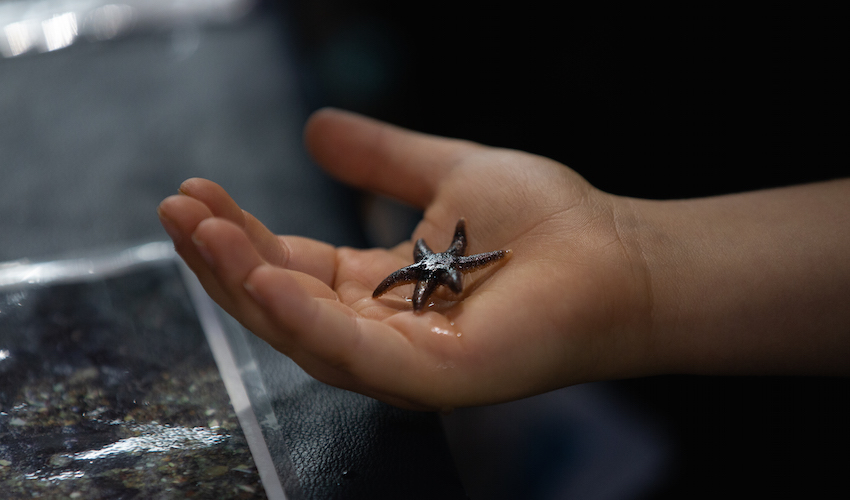Researchers uncover clues to mysterious sea star disease

Six-rayed sea stars are falling victim to a devastating condition known as sea star wasting disease. (Photo by Wil Matthews)
Research reveals the impact of SF Bay currents on a marine epidemic
All along North America’s West Coast, sea stars are vanishing. The colorful invertebrates are falling victim to one of the largest epidemics ever seen in the ocean: a mysterious plague known as sea star wasting disease. A new study by researchers in the lab of San Francisco State University Professor of Biology Sarah Cohen delves into the dramatic decline this disease has caused in Leptasterias — also known as six-rayed sea stars — around San Francisco Bay. The research shows that the afflicted sea stars may have a lot to tell us about why wasting disease ravages some populations and leaves others relatively untouched.
The disease, which begins as small white splotches on the sea star’s skin that slowly spread, eats away at flesh until the sea star’s body literally dissolves. To the average beachcomber, the sea star population crash is most obvious in the loss of large, eye-catching species like the colorful ochre star or the enormous sunflower star, a once-abundant species so devastated by wasting disease that it has disappeared entirely from the California coast.
The disappearance of six-rayed sea stars, a species that only grows to one or two inches across, is much easier to overlook. But their small size doesn’t mean they’re less important: Like their larger cousins, six-rayed stars are a crucial link in marine food chains, voraciously preying on animals like barnacles, snails and mussels and keeping their populations in check. With many sea star species in steep decline, the delicate tidepool ecosystems they occupy may be at risk, warns study lead author and SF State graduate student Noah Jaffe.

A close-up photo of the surface of a sea star showing a small white lesion characteristic of sea star wasting disease. (photo by Bing Huey)
The team combined sea star counts from Jaffe’s fieldwork with pre-existing survey data from numerous sources that was compiled by co-author Renate Eberl, an SF State alum and a biology instructor at Santa Rosa Junior College. This allowed them to estimate Leptasterias populations at 46 sites along the California coast, both north and south of the Bay, as part of their investigation into what is worsening the severity of wasting disease outbreaks. “More and more signs are pointing to environmental factors as a key part of the sea star wasting disease equation,” said Jaffe.
They found that sea star numbers have declined dramatically in the area around San Francisco. Six-rayed sea stars at many of these beaches died out completely — in contrast, sea stars are still present farther south and abundant in tidepools farther north, even when the disease is present. The key to this difference may lie in ocean current patterns: the waters of the less-affected sites are cool and salty, while the water that flows south out of the Bay is “warmer, less salty and more variable. Those are all stressful things for these animals,” Jaffe explained. And that stress may be making them more susceptible to the unknown virus or bacteria that causes wasting disease.
The team also made a surprise discovery in the lab — one that was, according to Jaffe, “a total accident.” Jamie Bucholz, a summer research intern and a co-author on the study, found that when infected six-rayed sea stars were treated with magnesium chloride, a chemical used to sedate the stars so they could be photographed, they survived longer than their untreated counterparts. “It was a striking thing to observe,” Jaffe said. It’s unclear why the magnesium chloride helped keep the sick sea stars alive, but the result may offer a clue about what traits make some sea stars more resistant to wasting disease than others.
The results of the research were published in PLOS One on Nov. 21.
“We still don’t know much about sea star wasting disease,” Jaffe cautioned. “Whether it’s a virus, whether it’s a series of bacterial infections that stars have become more susceptible to or whether it’s something else.” But this study fills in some of the blanks, he said, revealing that the environmental context in which the disease occurs can be as important as the disease itself.